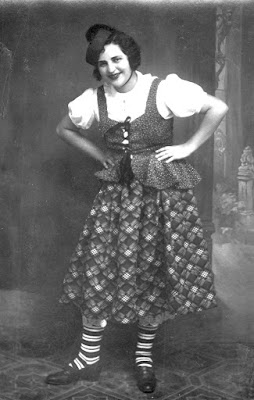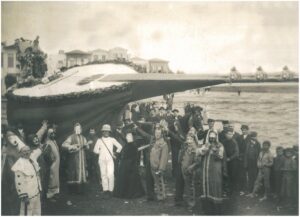
The history of the Rethymno Carnival dates back to the early 20thου century, specifically in 1901, during the Cretan State era. That's when we have a reference to the first carnival, showing that Rethymno has always been a pioneer in carnival events.
CARNIVAL EVENTS BEFORE THE UNION
Since 1883 1883as reported by the newspaper "Neos Radamanthys", there were carnival dances within family circles, while on the last Sunday of Carnival, disguised Rethymnians took to the streets to have fun. Evidently, Carnival has always been a significant event for Rethymno and its residents. Thus, in 1888as mentioned by the newspaper "Arkadion", a public event by a Club was postponed due to the Carnival festivities. This particular Club was apparently afraid to hold its event, fearing low attendance due to Carnival.
THE FIRST PARADE
This innate need of the people of Rethymno for revelry during Carnival led to the organization of the first organized carnival.
In an issue of the "Anagenesis" newspaper of Rethymno in 1900 we learn that a Carnival Organizing Committee had been formed. The inspiration for organizing this first carnival came from the Philo-Educational Club of Rethymno, with its President Konstantinos Petychakis.
Thus, in February 1901as mentioned by the renowned historian G.P. Ekkekakis, the Chania newspaper "Patris" published an article titled "Carnival in Rethymno". The report was signed by the newspaper's correspondent in Rethymno, using the pseudonym "Rethymniotis". The newspaper notably wrote:
"...In no other part of Crete were the carnivals celebrated as they were by us... The start of the parade was set by the Comitato [= the organizing group] from 3 pm. However, much earlier, Tsarou street was flooded with people. Windows and balconies bent—but also boasted—under the delightful weight that adorned them... The confetti prevailed early on, with beans and peas forming the reserve forces, and a less frequent firing of dragees! Precisely at 3 pm, the magnificent Carnival float paraded, overwhelmed by the paper war, which it too rained down. Then the masquerades appeared..."
Floats also participated in the parade, with the best ones receiving awards. One of the awarded floats depicted the government of the Cretan State:
"...A sufficiently beautifully decorated float represents our council chamber. Around a table sat the four ministers with their high hats, signing appointments... with salaries ranging from 1000 to 8000 drachmas. And it was pulled [this particular float not by animals, but] by the people, bent under the weight of taxes..."
Other float themes or compositions included: the freezing of works at the Port, the vain search for an economist graduate for the Bank of Crete, the General Inspector of Education who inspected schools with... a telescope, the lack of resources in the local Hospital, the reduced movement in the Rethymnian market, etc. The parade lasted 3 ½ hours, and the event concluded with fireworks, a rarity for that era.
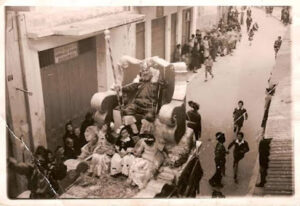
King Carnival on his float on Tsarou (Arkadiou) street (Archive of Kosmas Perpyrakis)
But in 1907, we had another organized carnival. The only surviving element from this is the address to King Carnival and his response. The writer satirizes the comfort in which the affluent families of Rethymno of that era lived, starkly contrasting with the deprived life of the majority of the residents. 1907 έχουμε οργανωμένο καρναβάλι. Το μόνο στοιχείο που σώζεται απ’ αυτό είναι η προσφώνηση προς τον Βασιλιά Καρνάβαλο και η αντιφώνησή του. Ο κειμενογράφος σατιρίζει την άνεση που ζουν οι εύπορες οικογένειες του Ρεθύμνου της εποχής, η οποία βρίσκεται σε κραυγαλέα αντίθεση με τη στερημένη ζωή της πλειονότητας των κατοίκων.
...Here the blue-blooded become citizens,
here both nobility and parchments are found,
only here French is spoken flawlessly,
and Parisian manners truly reign supreme.
Here, here, Carnival, every authority
with a demonic demeanor and a stern tongue,
and the aristocratic ladies in the cafés
teach the people proper conduct...
The next year, in 1908, 1908a carnival dance by the Rethymno Commercial Association took place in the luxurious "Idaion Andron" hall, aiming to raise funds for the construction of the Four Martyrs' Church. The dance was obviously a great success as it ended at 4:30 in the morning.
THE PEOPLE ENTERTAIN THEMSELVES UNORGANIZED BUT WITH SPIRIT
Certainly, these early carnivals did not happen by chance. The people of Rethymno, since ancient times, from the last years of the Ottoman rule, but especially after 1898 with the establishment of the Cretan State, never missed an opportunity for entertainment. And the Carnival period was an ideal time for such amusement. Poor hard workers with significant financial problems would temporarily set aside their worries and lead the carnival festivities. Many Rethymnians in those pre-war years sang and others played a musical instrument, such as the mandolin, violin, or harmonica. During Carnival, there was lively activity in houses, shops, and taverns of Rethymno and a different kind of noise in the streets from singers, young and old, who danced and sang with the accompaniment of instruments, "The Blossomed Almond Tree," "The Modistroula," "The Silence of the Night," and other unforgettable hits of the era.
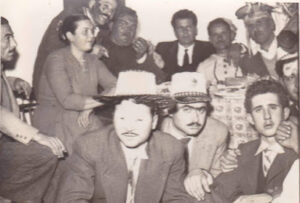
Rethymnians having fun in a house during the Carnival period. (Archive of the fb page RETHYMNO HISTORY-CULTURE)
But also, the inhabitants of the suburbs, and mainly those of Perivolia, from the day the Triodion (Carnival season) opened and every Sunday, would gather relatives in one of the family homes, eat, drink, and reminisce about the old times. Eventually, they would end up celebrating with the help of so many musicians and singers the area had, writes Alkiviadis Mavrakis.
The Perivolians would briefly forget the troubles of their hard lives and live a few days as if in another world, where labor, toil, deprivation, and misery were not the rulers, but carefreeness, joy, and ostensible wealth and abundance dominated. And there truly was some abundance because many raised a pig, slaughtered on Tsiknopempti (Smoky Thursday) or earlier, kept for family consumption and feasting. They would save from the previous summer a cheese fifteen okades (traditional weight measure) and a fresh cheese for the days of the Cheese-fare week. There was also the sour myzithra. Thus, on the carnival tables, lasagna with cheese, cheese pies, the pig's head cheese, tsiladia (thick syrup sweet), and boiled pork dominated. The sweet of the days was the "tsoulamas". During these days, no one stayed alone at home with their family, states Dimitris Vivilakis.
In Perivolia, however, the camel tradition was also revived. Let's see how Rethymno's troubadour, George Kalomenopoulos, describes it:
Everyone awaits her
every such holiday
like today's
See her arriving
wearing ...a dress...
of linen cloth
To see her emerge
a donkey's head
human legs
"Gkelama el-Gali"
with great appetite
starts the tune
And she makes jokes
greets ...bites
and spreads cheer
One ...collects it
another dances with her
playing the tambourine
Laughter, my God, laughter
makes the girls
who've followed since morning
to forget
to go home
and eat
Mothers wait
and all curse
waving rods and sticks
Night now approaches
they haven't returned yet
Ah! damned camel
They arrive at night
the girls, a flock
sneaky sparrows
The children's Fate
turns peace
to mourning ...in the homes.
**CARNIVAL IN THE CITY**
But even within the city of Rethymno, the spirit was inexhaustible. Some of the traditional revelers of Rethymno formed the famous "comitato," with specialties and qualities that would aid in the better organization of the informal carnival. They were people from all social classes, rich and poor, educated and day laborers, who during those days would forget these differences and unite their forces for the same purpose.
With the opening of the Triodion, all of them were in a general "mobilization": actors, jesters, musicians, all amateurs, lovers of entertainment and innocent, even if somewhat exaggerated, satire. Musicians, instrumentalists, and singers of the era from all classes, scientists, carpenters, shoemakers, employees were excellently trained in both classical music and the contemporary music of the mandolinata, tetraphony, and Cretan music. Not at all coincidental, given that the Municipal Philharmonic was a school with excellent teachers, perhaps a unique example in both Crete and Greece.
During those days, especially on the last Sunday of Carnival, nearly all homes were open with tables set inside with the season's appetizers, and everyone, in groups, would visit them and eat and drink with songs and dances. Sausages, smoked pork, siglina (salted and smoked fatty pork), homemade sausages, and whatever else was available at that time were on the table, generously shared.
The fun began after the liturgy. Until the afternoon hours when King Carnival would pass, the festivities reached their peak, and everyone, singing, would go out to Tsarou (Arkadiou) street and start the bean war. From the balconies, filled with both masked and unmasked people, they held large bags filled with beans and bombarded each other, both those in opposite balconies or windows and the passersby. The wealthier had streamers and confetti. The street party lasted until nightfall, but in the houses, it continued until morning. The next morning, Tsarou street was covered with a thick layer of beans, streamers, and confetti.
Of course, there were also periodic bans, intertwined with the social and political conditions of the times. Thus, in 1909 we have a police order banning "prosopion" masks, as well as disguising in religious clerics' attire.
**CARNIVAL EVENTS AFTER THE UNION**
**THE CARNIVAL OF 1915**
in 1915two years after the Union of Crete with Greece, we have the first relatively organized, large carnival, always with a private initiative.

The famous mandolin of 1915. (Manos Astrinakis Archive)
That year, the brothers Nikos and Vangelis Moundrianakis, furniture makers from Pigi, crafted a huge mandolin on a long cart that was twelve meters long, four meters wide, and two meters deep. They made the frame with thin woods and covered it with cloth that had brown and white stripes, like those on a mandolin. The keys were the masks, and the saddle of this original mandolin were the strings, white ropes, and around it were flowers. The throne of the Carnival King was secured on the cart but appeared to be at the base of the mandolin where the strings are fastened.
Several Rethymnians participated in their company: The teachers Stavrakakis and Iliakakis who played the violin, Manolis (Chrysanthos) Vitzikounakis played the mandolin, Artemis Bempisakis, M. Iliakakis, K. Varouhas, P. Skandalis, Io. Kampourakis, N. Gounaridis were good singers. They had formed an excellent carnival group, while Nikos Moundrianakis played the guitar beautifully and sang splendidly. All of them would fit inside the giant mandolin's carcass.
King Carnival was the milkman Manolis Kanakakis, father of the great Rethymnian sculptor Ioannis Kanakakis. Despite his large family, with ten or twelve children and the daily struggle for survival, he always led the festivities. The King sat on his throne and shook the mandolin's strings with a churner he had in the shop to mix milk.
All the action was transferred to Sochora because only there was enough space for the builders to work and for the chariot to fit. They harnessed a huge horse, a mare led by an Ottoman, who owned and worked it on other days carrying stones and oils and knew it well.
When everyone took their places, the triumphal parade of the Carnival began.
The King, dressed in red and gold clothes and a crown, gave the commands.
– Forward, children, let's leave
all of us for foreign lands
with our own King
of Carnival's Crown...
**The "blooming almond tree" followed along with other songs of the era. The melodic voices and sounds of the instruments, as if emerging from the giant mandolin, created a truly unique spectacle.**
The Carnival cart began its journey from Marmaraporta, passed through Ambouhouri, Megali Porta, Ammos Porta, traversed Arkadiou Street, up to Rodinou's bakery at the port's entrance, and then returned the same way.
The signal for the return was given by King Carnival with unimaginable laughter, voices, and songs. The balconies, windows, and rooftops of houses were filled with people throwing flowers and beans at the Carnival's mandolin.
And everyone teased the King. And he signed here and there. And he had a huge reed for a pen and the mare’s… behind as an inkpot. There he would dip and sign.
**THE CONTRIBUTION OF THE ASIA MINOR REFUGEES**
In 1922, the Asia Minor Catastrophe occurred, and with the population exchange, thousands of Asia Minor refugees came to Greece. Many of them arrived in Rethymno. The Asia Minor refugees, people with education, entrepreneurial spirit, and dignity, developed a remarkable community in Rethymno. The urban population from Asia Minor, added to the Cretan urban population, determined the fusion of rich tradition and culture with the local tradition, influencing, among others, music, dance, customs, and the general structures of entertainment and socialization.
The Asia Minor refugees also participated in the carnival festivities, using their own musical instruments, the violin and the santouri, singing songs of their unforgettable homelands. But even when there were no musicians, they took a pan, set the rhythm, and the dance and song began. Their homes were always open during those days, and one family would visit another. The table was always set with all the delicacies they could offer. Their specialties were Smyrna meatballs, vegetable pies, and cheese pies, as well as kurkoubinia made from fluffy dough that swam in syrup. And when the appetizers were finished, they would fry olives in the pan, and the party continued until morning. And of course, there were those in disguise. Someone from the group would leave, go home, put on whatever old clothes he found, and come back with his face uncovered, joking with the group. Another disguised as a Turk with a yatagan who "threatened" the group, another as a priest with a censer to bless them...
On Clean Monday, everyone went to the sea with their Lenten food. From early on, some went to collect limpets and sea urchins, and when the groups gathered, they offered them or made a large sea urchin salad. At some point, "the donkey" would appear, someone with a lot of humor and witty remarks who would pass through the groups making various jokes. Also, the lyra players of Rethymno were there, playing for free that day for all the groups.
**THE DANCES OF THE LYCEUM OF GREEK WOMEN**
in 1917 the Lyceum of Greek Women of Rethymno was founded. Its establishment was a milestone for the lives of the city's women and for the social life of Rethymno.
Famous were the dances of the Lyceum of Greek Women during the Carnival period. Initially, these were held in "Idaion Andron," a luxuriously elegant hall on Melissinou Street, opposite the Catholic church, owned by Charalambos Spandagos, which had been built during the period of Russian rule. After the completion of the Lyceum of Greek Women's building at the end of the promenade, the dances were held there.
In these dances, attended by Rethymno's then high society, men wore tuxedos or black suits, while women wore magnificent dresses that highlighted their grace and beauty even more. In all the dances, the music was live from the Municipal Philharmonic, under the guidance of the chief musician, Nikos Gkinos.
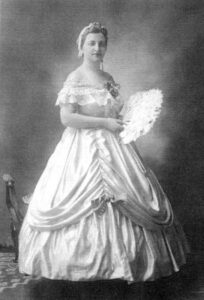
Maria Valari in an evening gown ready for the Lyceum of Greek Women's dance.
On Tsiknopempti (Smoky Thursday), the children's carnival dance took place early in the afternoon. In the evening, the famous "dance of the Apaches" was held, the only dance where men were disguised. They were dressed as Apaches (marginal types) with a black undershirt or shirt, a red handkerchief around the neck and waist, and black trousers.
Themistoklis Valaris mentions: <After the Waltzes, Tangos, and Polkas, the music played a part of the Lanciers melody as a signal to escort our ladies, so we could form our squares. After the Lanciers, again dancing until the music played the sounds of the Quadrille, then again we escorted ladies and stood opposite a couple to dance them, with the related commands and all the joy. The last figure of the Quadrille was maintained for over an hour and a half. We went up dancing with the music to the gallery of the hall, came down to the streets again dancing until we could hear the music, led by a young man. After this frenzy of joy, we sat at tables, which had been set while we danced Quadrilles in the street, eating the appetizers prepared by the ladies of the Lyceum and drinking beer. It was already five in the morning, when with songs and incredible joy we took to the streets, knocking on doors to wake up our fellow citizens, and with enthusiastic voices, we went home early in the morning."
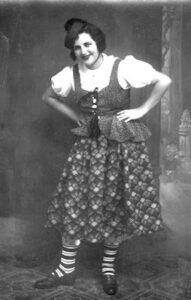
Emilia Valari in a carnival costume at a dance of the Lyceum of Greek Women.
However, the dance of the Lyceum of Greek Women that surpassed all splendor was the one on the last Sunday of Carnival. Themistoklis Valaris describes vividly:"This dance was for those in disguise, where men wore their usual formal clothes, but for women, the issue was different. They had to choose a dress design from old pictures or other old designs that suited them best and make it. Around nine in the evening, the hall opened, which, thanks to the diffused lighting, shone like a fairy tale cage. So, the couples gradually arrived. Almost all the ladies and girls were masked. Some with precious crinolines, others with external stolas, ballerinas with white skirts, Dutch women with tight dark busts, long and wide skirts with clogs, Cossacks with glossy boots, Spaniards with colorful rich skirts, pierrots, and anything else one can imagine. Soon the hall filled up, and before the dance started, there was a parade of the disguised in the middle of the hall, so that all attendees could enjoy such a beautiful sight. Immediately after, the dances of the era began. Waltzes, Tangos, Lanciers, Quadrilles. In the last figure of the Quadrille, the hall was filled with colorful balloons, which like a torrent, fell from the ceiling, where they had been appropriately placed, and almost covered the dancers."».
**ASSOCIATIONS KEEP CARNIVAL ALIVE**
In years without an official carnival and parade, various associations undertook to maintain the tradition and keep the carnival spirit at a high level.
Thus, in 1924on February 2nd, the Ladies' Association organized a dance evening, during which a comedy would be played by young artists.
in 1925 the Ladies' Association again organized three carnival dance evenings, one of which was for children, while the Red Cross also organized its carnival dance at "Idaion Andron."
in 1930 the Lyceum of Greek Women organized a carnival dance, with and without costumes, on the last Sunday of Carnival, for the first time at the Military Club. Although the dance was supposed to involve masks, most participants chose to show their faces. The overcrowding at this dance was such that participants couldn't enjoy their carefully prepared disguises.
in 1933 the Municipality of Rethymno organized a carnival dance at "Idaion Andron" to financially support the Philharmonic. The organizing committee was comprised of the Mayor, Titos Petychakis, along with two Municipal Councillors. That year, carnival dances were also held by the School Board at the "House of Education," which " "represented almost all the families of Rethymno," as well as by the Lyceum of Greek Women, at "Idaion Andron," with a large turnout and revelry until morning.
Και το 1935 there was a large number of carnival dances. The Lyceum of Greek Women at "Idaion Andron" with a general admission of 15 drachmas, the Association of Disabled and War Victims at the Conservatory, and the "great dance of the Rethymno Conservatory" on the last Sunday of Carnival.μέγα χορό του Ωδείου Ρεθύμνου» την τελευταία Κυριακή της Αποκριάς.
As we rapidly approach World War II, Rethymno continues to resist stubbornly. 1937 the Rethymno Ladies' Association organizes a grand carnival dance and a children's one, while the Rethymno Conservatory also holds its annual carnival dance. These appear to be the last pre-war carnival dances.
**APPROACHING WAR**
The joy of the people of Rethymno remained at its peak despite the financial problems faced by almost the entire local community. Some years, due to national issues and adventures, there might not have been massive celebrations, but the people of Rethymno never lost their spirit.
in 1931 In 1931, another attempt at an organized carnival was made, overseen by the Carnival Committee. As reported by the local press, "Carnival with a άσμαsong, bean, camel, clown, quack doctor, these classic carnival types, along with 'badly formed gangs of masqueraders,' will parade starting at the Heroes' Square on Arkadiou - Palaiologou and will end at the Square of the Barracks. Cash prizes were even established: 500, 300, 200, and 100 drachmas.
in 1933during the interwar period, we learn about Carnival in Rethymno through the press. «"Carnival was celebrated this year with much vivacity. We haven't seen so many masqueraders in years. Both the dressing up and the fun were general. Both in the working classes and the bourgeoisie of Rethymno, known for its blue blood." The Journalist, with a great sense of humor due to the season, makes a special reference to the students of the higher grades of the Gymnasium who, hidden behind masks and anonymity, did not let the people of Rethymno sleep with their not-so-melodic voices."Unfortunately, the lesson of Music is taught little in our schools. The larynxes of our young people, usually deprived of this, disturbed the sleep of the grumblers who retire with the birds. We hope that the new generations, thanks to phonographs and the popularization of music, will appear more melodic."
Of course, not everyone saw Carnival in a good light and enjoyed it. There were some conservatives who only saw misfortunes behind the carnival celebrations. Thus, in 1922 a letter signed "A guardian" was published in the local press, asking not to grant the use of the "sacred space" of the "House of Education" hall to Gymnasium students to hold their carnival dance to support the School's fund. This particular parent also blames the School Principal who suggested the proposal and the School Board that agreed to consider it.
**POST-WAR CARNIVALS**
**THE FIRST DANCES**
After World War II and the Civil War, the country slowly began to find its footing again. People started to return to their daily routines and old habits.
in 1946 In 1946, carnival dances slowly began again in Rethymno. The farmers held their carnival dance on Tsiknopempti at the "Olympia" cinema, and two days later, the Association of Reserve Old Combatants organized a carnival dance at the same venue "for the dowry of a poor member's daughter."
in 1950 the Ladies' Association held its annual dance at the "REX" cinema since "Idaion Andron" had been destroyed by German bombings. The same year, the Lyceum of Greek Women held its traditional Children's dance and the dance of the Apaches on Tsiknopempti, while on the last Sunday of Carnival, it organized its grand carnival dance.
Και το 1953 various Associations and Clubs, as seen from their announcements in the newspapers of the time, held the usual carnival dances, though they did not have the joy and response of previous years.
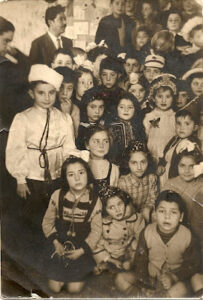
Carnival dance at the private School of Amalia Zanidaki in 1954. (Archive page fb RETHYMNO HISTORY-CULTURE)
in 1954 it seems that carnival activity is minimal in Rethymno. In contrast, in neighboring Heraklion, preparations are underway for major carnival events. "...we are distinguished for our seriousness and ..skepticism. After all, those who want can go to Heraklion to have fun..." writes a local newspaper of the time.εμείς διακρινόμαστε για τη σοβαρότητα και το ..σκεπτικισμό μας. Εξάλλου όσοι θέλουν μπορούνε να πάνε στο Ηράκλειο για να διασκεδάσουν..» γράφει τοπική εφημερίδα της εποχής.
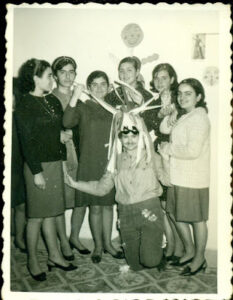
Carnival dance at the Girls' Gymnasium. (Archive page fb RETHYMNO HISTORY-CULTURE)
In the following years, out of habit, the well-known Associations held their annual carnival dances without the joy and participation of past years.
Text: Nikos Deredakis.

